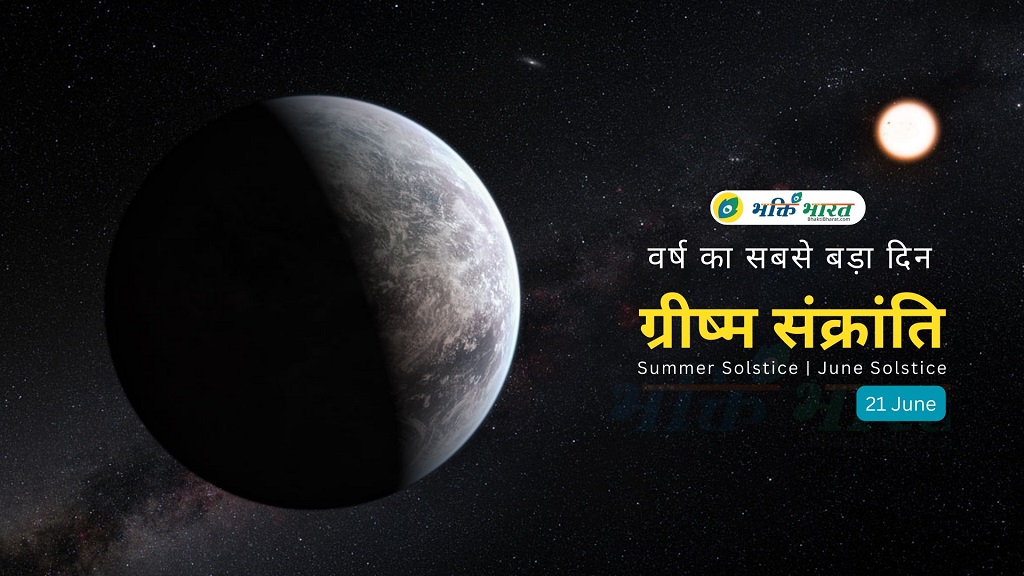Make Bhakti Bharat Your Preferred Source on Google

Summer Solstice | June Solstice (ग्रीष्म संक्रांति | जून संक्रांति)

The summer solstice occurs when the Earth's inclination towards the Sun is maximum. Therefore, on the day of the summer solstice, the Sun appears at its highest altitude with a midday position that changes very little for several days before and after the summer solstice. June 21 is the longest day in the Northern Hemisphere, technically this day is called the Summer Solstice. The amount of light received by a specific area in the Northern Hemisphere during the summer solstice depends on that location's latitudinal location.It is a natural phenomenon that occurs twice a year in each hemisphere of the Earth, once in summer and once in winter.
What Happens during the Summer Solstice?
This day is characterized by the high amount of energy received from the surya. To avoid any confusion the solstice is preferably called June solstice (Northern solstice) and December solstice (Southern solstice). Summer Solstice is also known as Saundarya Sankranti. During summer solstice day is the longest day of the year and during winter solstice day is the shortest day of the year.
About Summer Solstice:
❀ It is the longest day and shortest night of the year in the Northern Hemisphere.
❀ During this time the countries of the Northern Hemisphere are closest to the Sun and the Sun shines upwards at the Tropic of Cancer (23.5° North).
❀ The Tropics of Cancer and Capricorn lie to the north and south of the equator at latitudes of 23.5°.
❀ Latitude is the measure of the distance of a place from the equator.
❀ The Sun never sets during the solstice in the Arctic Circle.
In Hindu astrology, the summer solstice is known as tropical Dakshinayana. However, the Nakshatra Dakshinayan starts from Kark Sankranti - from this day Asurakal starts which is not good for starting auspicious work.
What Happens during the Summer Solstice?
This day is characterized by the high amount of energy received from the surya. To avoid any confusion the solstice is preferably called June solstice (Northern solstice) and December solstice (Southern solstice). Summer Solstice is also known as Saundarya Sankranti. During summer solstice day is the longest day of the year and during winter solstice day is the shortest day of the year.
About Summer Solstice:
❀ It is the longest day and shortest night of the year in the Northern Hemisphere.
❀ During this time the countries of the Northern Hemisphere are closest to the Sun and the Sun shines upwards at the Tropic of Cancer (23.5° North).
❀ The Tropics of Cancer and Capricorn lie to the north and south of the equator at latitudes of 23.5°.
❀ Latitude is the measure of the distance of a place from the equator.
❀ The Sun never sets during the solstice in the Arctic Circle.
In Hindu astrology, the summer solstice is known as tropical Dakshinayana. However, the Nakshatra Dakshinayan starts from Kark Sankranti - from this day Asurakal starts which is not good for starting auspicious work.
ग्रीष्म संक्रांति | जून संक्रांति हिन्दी में पढ़ें
ग्रीष्म संक्रांति तब होती है जब पृथ्वी का सूर्य की ओर झुकाव अधिकतम होता है। इसलिए, ग्रीष्म संक्रांति के दिन, सूर्य दोपहर की स्थिति के साथ अपनी उच्चतम ऊंचाई पर दिखाई देता है जो ग्रीष्म संक्रांति से पहले और बाद में कई दिनों तक बहुत कम बदलता है। 21 जून उत्तरी गोलार्ध में सबसे लंबा दिन होता है, तकनीकी रूप से इस दिन को ग्रीष्म संक्रांति कहा जाता है। ग्रीष्म संक्रांति के दौरान उत्तरी गोलार्ध में एक विशिष्ट क्षेत्र द्वारा प्राप्त प्रकाश की मात्रा उस स्थान के अक्षांशीय स्थान पर निर्भर करती है।Read Also
- Trayodashi Vrat
- Jagannath Dham
- Sankranti
- Pana Sankranti
- Makar Sankranti
- Poush Sankranti
- Ghee Sankranti
- Phool Dei
- Summer Solstice | June Solstice
- Spring Equinox | March Equinox
Blogs Summer Solstice BlogsJune Solstice BlogsJune Sankranti BlogsNakshatra Blogs
If you love this blogs please like, share or comment!
 Follow Bhakti Bharat Whatsapp Channel »
Follow Bhakti Bharat Whatsapp Channel »
Bookmark / Save this blogs for future
* Please share any of your suggestions or ideas with us.
 Follow Bhakti Bharat Whatsapp Channel »
Follow Bhakti Bharat Whatsapp Channel »Bookmark / Save this blogs for future
* Please share any of your suggestions or ideas with us.
** Please write your any type of feedback or suggestion(s) on our contact us page. Whatever you think, (+) or (-) doesn't metter!
Quick Links:
- Famous Mata temple of Delhi NCR
- Famous Kali Temple in Delhi NCR
- Char Dham
- 12 Jyotirlinga
- Sapta Moksha Puri
- Famous and Popular Temples in Brajbhoomi
- List Of ISKCON Temples
- Famous Birla Temples
- Delhi's Famous Temple of the Mahabharat
- Famous Shiv Mandir in Delhi NCR
- Famous Hanuman Balaji Mandir of Delhi
- Famous Temples in Delhi, Ghaziabad, Noida and Gurugram
- Top Famous Temple of Sirsaganj




